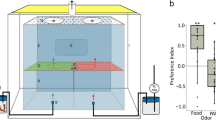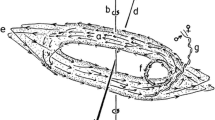Abstract
At the end of summer, males of Polistes gallicusfly in swarms around vertical landmarks and land in clusters on their favorite perches, where they drag their legs and abdomen. Here males occasionally crowd around a perched female; they make no effort to defend an exclusive mating territory but instead attempt to copulate by displacing rivals from the female. In this work we describe this spatial-nuptial system, which entails site fidelity without territoriality, unisexual swarms, common patrol routes, collective sexual approaches, and “scramble competition polygyny.” Mating success is evaluated in relation to the familiarity with flight paths (“routine patrollers” versus “newcomers”), to the type of sexual approach (“single” males versus “in- group” males), and, in the laboratory, to the individual activity level.
Similar content being viewed by others
References
Alcock, J. (1978). Notes on male mate-locating behaviour in some bees and wasps of Arizona.Pan-Pacif. Entomol. 54: 215–225.
Alcock, J. (1980). Natural selection and the mating systems of solitary bees.Am. Sci. 68: 146–153.
Alcock, J., Jones, C. E., and Buchmann, S. L. (1976). Location before emergence of the female bee,Centris pallida, by its male (Hymenoptera: Anthophoridae).J. Zool. 179: 189–199.
Alcock, J., Eickwort, G. C., and Eickwort, K. R. (1977a). The reproductive behavior ofAnthidium maculosum (Hymenoptera: Megachilidae) and the evolutionary significance of multiple copulations by females.Behav. Ecol. Sociobiol. 2: 385–396.
Alcock, J., Jones, C. E., and Buchmann, S. L. (1977b). Male mating strategies in the beeCentris pallida Fox (Hymenoptera: Anthophoridae).Am. Nat. 111: 145–155.
Allan, J. D., and Flecker. A. S. (1989). The mating biology of a mass-swarming may fly.Anim. Behav. 37: 361–371.
Beani, L. (1987). Spatial behaviour in males of two sympatric species ofPolistes (Hymenoptera, Vespidae). In Le Moli, F. (ed.),Ethological Perspectives in Social and Presocial Arthropods, Pubbl. Ist. Eng. Univ. Pavia 36, pp. 19–21.
Beani, L., and Turillazzi, S. (1987). Swarm patrolling inPolistes gallicus males (Hymenoptera. Vespidae): An example of non-territorial mating system. InAbstracts, XX International Ethological Conference, Madison, Wis., pp. 10–11.
Beani, L., and Turillazzi, S. (1988a). Alternative mating tactics in malesof Polistes dominulus (Hymenoptera: Vespidae).Behav. Ecol. Sociobiol. 22: 257–264.
Beani, L., and Turillazzi, S. (1988b). An experiment on the relationship between spatial behaviour and mating success in the males ofPolistes gallicus L. (Hymenoptera: Vespidae).Monit. Zool. Ital. 22(3): 323–330.
Beani, L., and Calloni, C. (in press). Male rubbing behaviour and the hypothesis of a pheromonal release in Polistinae wasps.Ethol. Ecol. & Evol., Special Issue.
Beani, L., and Turillazzi, S. (1990). Overlap at landmarks by lek-territorial and swarming males of two sympatric Polistine wasps (Hymenoptera: Vespidae)Ethol. Ecol. & Evol. (3).
Beani, L., Cervo, R., and Turillazzi, S. (1987). Territorial and patrolling males of three EuropeanPolistes wasps (Hymenoptera, Vespidae). In Eder, J., and Rembold H. (eds.),Chemistry and Biology of Social Insects, Verlag J. Peperny, Munchen, p. 188.
Bradbury, J. W., and Gibson, R. M. (1983). Leks and mate choice. In Bateson, P. (ed.),Mate Choice, Cambridge University Press, Cambridge, pp. 109–138.
Day, M. (1979). The species of Hymenoptera described by Linnaeus in the generaSphex, Chrysis, Vespa, Apis andMutilla.Biol. J. Linn. Soc. 12(1): 45–84.
Di Stefano, S. L. (1972). Inconsuete sciamature autunnali di maschi diPolistes (Hymenoptera, Vespidae).Atti IX Congr. Naz. Ital. Ent., pp. 59–64.
Downes, J. A. (1969). The swarming and mating flight of Diptera.Annu. Rev. Entomol. 14: 271–298.
Eberhard, W. G. (1980). Horned beetles.Sci. Am. 242: 124–131.
Eberhard, W. G. (1985).Sexual Selection and Animal Genitalia, Harvard University Press, Cambridge, Mass., pp. 84–106.
Fernald, H. T. (1940). A probable prenuptial gathering ofPolistes (Hymenoptera: Vespidae).Ann. Entomol Soc. Am. 33: 33–34.
Gaulin, S. J. C., and Fitzgerald, R. W. (1986). Sex differences in spatial ability: An evolutionary hypothesis and test.Am. Nat. 127(1): 74–88.
Hölldobler, B. (1976). The behavioural ecology of mating in harvester ants (Hymenoptera: Formicidae: Pogonomyrmex).Behav. Ecol. Sociobiol. 1: 405–423.
Jeanne, R. L., and Castellón Bermúdez, E. G. (1980). Reproductive behaviour of a male neotropical social wasp.Mischocyttarus drewseni (Hymenoptera: Vespidae).J. Kans. Entomol. Soc. 53(2): 271–276.
Kasuya, E. (1981). Male mating territory in a Japanese paper wasp,Polistes jadwigae Dalla Toree (Hymenoptera, Vespidae).Kontyu 49(4): 607–614.
Lin, N. (1972). Territorial behavior among males of the social waspPolistes exclamons Viereck.Proc. Entomol. Soc. Wash. 74: 148–155.
Litte, M. (1979).Mischocyttarus flavitarsis in Arizona: Social and nesting biology of a polistine wasp.Z. Tierpsychol. 50: 282–312.
Litte, M. (1981). Social biology of the Polistine waspMischocyttarus labiatus: Survival in a Colombian rain forest.Smithson. Contrib. Zool. 327: 1–27.
MacDonald, J. F., Akre, R. D., and Hill, W. B. (1980). Comparative biology and behavior ofVespula atropilosa andV. pensylvanica (Hymenoptera: Vespidae).Melanderia 18: 1–93.
Matthes-Sears, W., and Alcock, J. (1986). Hilltopping behavior ofPolistes commanchus navajoe (Hymenoptera: Vespidae).Ethology 71: 42–53.
Michener, C. D. (1989). Name changes to be avoided: Examples inPolistes andBombus. Sphecos18: 5–6.
Post, D. C. (1980). Observations on male behavior of the eastern yellowjacket,Vespula maculifrons (Hymenoptera; Vespidae).Entomol. News 91(4): 113–116.
Post, D. C., and Jeanne, R. L. (1983). Male reproductive behavior of the social waspPolistes fuscatus (Hymenoptera: Vespidae),Z. Tierpsychol. 62: 157–171.
Rau, P. (1929). At the end of the season withPolistes rubiginosus (Hym.: Vespidae).Entomol. News 40: 7–13.
Richards, O. W. (1978). The Australian social wasps (Hymenoptera: Vespidae).Aust. J. Zool. Ser,61: 1–132.
Schöne, H., and Tengo, J. (1981). Competition of males, courtship behaviour and chemical communication in the digger waspBembix rostrata (Hymenoptera, Sphecidae).Behaviour 77: 44–66.
Schwagmeyer, P. L. (1988). Scramble-competition polygyny in an asocial mammal. Male mobility and mating success.Am. Nat. 131(6): 885–892.
Sullivan, R. T. (1980). Insect swarming and mating.Fla Entomol. 64(1): 44–65.
Thornhill, R., and Alcock, J. (1983).The Evolution of Insect Mating Systems, Harvard University Press, Cambridge, Mass., and London.
Turillazzi, S., and Cervo, R. (1982). Territorial behaviour in males ofP. nimpha (Christ) (Hymenoptera, Vespidae).2. Tierpsychol. 58: 174–180.
Turillazzi, S., and Turillazzi Marucelli, C. (1985). Notes on the social behaviour ofRopalidia fasciata (F.) in West Jawa (Hymenoptera Vespidae).Monit. Zool. Ital. 19: 219–230.
van den Assem, J., Gijswijt, M. J., and Nubel, B. K., (1980). Observation on courtship and mating strategies in a few species of parasitic wasps (Chalcidoidea).Netherlands J. Zool. 30: 208–227.
Wenzel, J. W. (1987). Male reproductive behavior and mandibular glands inPolistes major (Hymenoptera: Vespidae).Insect Soc. 34: 44–57.
West-Eberhard, M. J. (1969). The social biology of polistine wasps.Misc. Publ. Mus. Zool. Univ. Mich. 140: 1–101.
Yoshikawa, K. (1963). Introductory studies on the life economy of polistine wasps. V. Three stages relating to hibernation.J. Biol. Osaka City Univ. 14: 87–96.
Author information
Authors and Affiliations
Rights and permissions
About this article
Cite this article
Beani, L., Turillazzi, S. Male swarms at landmarks and scramble competition polygyny inPolistes gallicus (Hymenoptera: Vespidae). J Insect Behav 3, 545–556 (1990). https://doi.org/10.1007/BF01052017
Accepted:
Issue Date:
DOI: https://doi.org/10.1007/BF01052017




